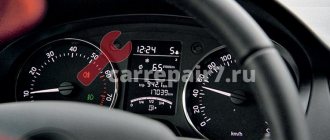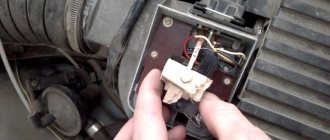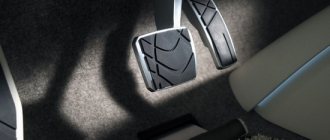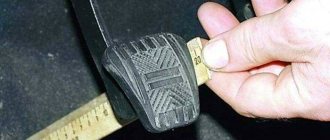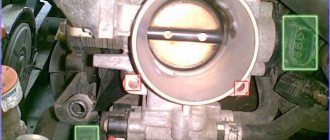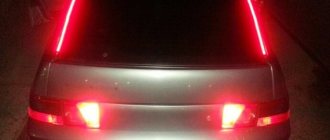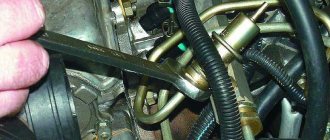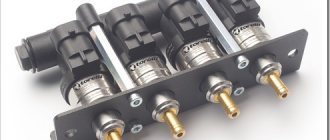November 21, 2022 Category: Useful information.
The owner of a diesel car may encounter a situation where the engine does not respond to pressing the gas pedal and does not gain speed.
The cause of this problem may be trivial things regarding car maintenance, or it may be serious malfunctions. Let's look at the most likely ones.
Causes of failures when pressing the gas pedal
The gas (accelerator) pedal is a control with which the driver doses the volume of the combustible mixture, which at that particular moment must enter the engine cylinders in order for the car to drive faster or slower, but several systems are responsible for the ratio of air and fuel (mixture quality) , controlled not by the driver, but by the “brain” of the car (ECU), or mechanics (carburetor).
Gas pedal
In a carburetor engine, this dosing is easier - the cross-section of the main jet opening through which gasoline passes becomes larger or smaller. If necessary, only the idle jet works; when you press the pedal, both work together. Next, the main thing for the engine is to ignite the mixture with a high-quality spark, and the required force to turn the crankshaft will be obtained.
In modern injection engines and diesel engines, changing the position of the gas pedal gives a command, before executing which, the electronic unit “checks” with the readings of pressure and temperature sensors, and with data. showing the speed of the crankshaft and camshafts, the volume of air consumed and the content of residual oxygen in the exhaust gases.
Failure when pressing the gas occurs if:
- Data from one or more sensors is incorrect, missing, or does not match the baseline.
- Electronics has accumulated a large number of critical errors (the dump and flash memory need to be rewritten).
- Something is preventing fuel from reaching the cylinders in full.
- Something makes it difficult for air to fully enter the cylinders.
- Something makes it difficult to evacuate the spent mixture into the exhaust manifold.
- One or more cylinders are misfiring.
- The spark does not ignite at a certain moment - the advance has been lost.
If the car is “old”, it will require comprehensive diagnostics, because the problem can be caused by all these reasons at the same time.
Injectors, intake and exhaust manifolds wear out and become clogged, Hall sensors and explosive wires fail due to age, compression decreases due to wear, springs and hydraulic compensators in the cylinder head get tired, and advance settings “float”. On cars with short mileage (up to 100 thousand km), one unit usually fails. During the runs before the second maintenance, most often a factory defect or a consequence of poor quality assembly “comes out”.
Specific engine faults
Old car models with a carburetor are still quite actively used by domestic car enthusiasts. Failure of various components of such power systems manifests itself in a noticeable drop in engine power and has the following characteristic malfunctions:
- Fuel pump failures causing a drop in pressure in the system.
- Dirt gets into the carburetor, which clogs the jets and causes problems with the operation of the needle valve.
- Incorrect adjustment of the composition of the combustible mixture.
- Malfunctions in the operation of the carburetor dampers and economizer valve.
- Incorrect float operation.
Some new engine models have one or more turbines that force air into the combustion chamber, thereby increasing the amount of horsepower that the power unit is capable of producing. Breakdowns or disruptions in their operation are caused by a sharp drop in the throttle response of the power unit.
A drop in engine power should be the reason for vehicle diagnostics to identify the malfunction and completely eliminate it. It’s good if the cause of loss of dynamics turns out to be such easily removable reasons as low-quality fuel, clogged filters or old spark plugs. But malfunctions in the operation of the gas distribution mechanism, wear of the piston group and other more serious problems require immediate repair, as they can lead to significant damage and significantly higher monetary costs.
How to understand why failure occurs when you press the accelerator
Often, the source of the problem is indicated by additional signs of a malfunction - for example, a “reluctant” engine start “on cold”, a general decrease in power (even before failures appear), increased fuel consumption. A very important criterion is when the problem manifests itself. If you notice that the engine spins up nonlinearly, as if there is a counterforce preventing it from gaining speed, most likely the reason is a clogged fuel or air filter. If the car “jerks” during acceleration with a smooth opening of the throttle, and, when pressed more intensely, it suddenly “shoots” - the jerks are associated with a lack of fuel. Dips during over-throttle and prolonged pressing and holding of the gas pedal, multiplied by difficult starting of a cold engine, indicate a malfunction of one or more spark plugs (and their coils).
Flooded or faulty spark plugs can also cause the gas pedal to fail.
The spark plugs that come with the car from the factory are more durable than most commercially available consumables, so it is recommended to do the second and subsequent replacements at shorter intervals.
Sometimes the problems of loss of throttle response, jerking, stepwise acceleration during acceleration are not at all related to the operation of the engine. On cars with automatic transmission, this is how severe wear appears. You will notice it when switching during acceleration - first a second delay without reaction to the gas pedal, then a push and acceleration. In cars with gas equipment, such a reaction to gas begins to occur when the gas reducer or its sensor breaks down. At the same time, the car begins to consume two to three times more gas. In diesel engines, an adequate response to vigorous pressing of the gas pedal is greatly impaired by refueling with low-quality fuel with a high sulfur content, or with a type of diesel fuel that does not correspond to the season.
The main reasons for the lack of engine dynamics
A driver who constantly operates a car can easily detect a deterioration in the dynamic characteristics of the engine, which manifests itself in sluggish acceleration, poor traction, and increased fuel and oil consumption. These processes are often accompanied by the appearance of bluish or black exhaust. Most often this is due to the following reasons:
- Insufficient heating of the power unit.
- Poor quality of fuel used.
- Clogged air filter and malfunction of the air supply system.
- Problems with the gas distribution mechanism.
- Malfunctions of fuel supply systems.
- Sensor malfunction.
- Ignition system malfunctions.
- Weak compression in the cylinders.
- Incorrect operation of the vehicle's ECU.
- Specific malfunctions of engines with a turbocharger or carburetor.
Gaps during acceleration
When accelerating a car, the load on the engine increases, which requires more fuel-air mixture, so most problems that cause failure during acceleration are associated with a lack of fuel or air. Check the condition of the fuel pump, filters, rail pressure, spark quality (in a gasoline engine). Changing the settings - mixture quality and ignition timing - is controlled by the electronics, so it is better to start diagnosing the problem by checking the dynamic indicators with a scanner directly during the trip.
Remember: if your car is equipped with an electronic “E-gas” pedal, there are usually three reasons that cause “failure” when you press it: shorted contacts, failure of the clutch and brake position sensor, or a system error.
When you press the gas pedal hard, used cars often experience a delay in the opening of the intake manifold flaps. This is a purely mechanical problem when, due to age and vigorous use, the collector becomes overgrown from the inside with a thick layer of soot “spitted out” by the cylinders of oil (and soot from the USR). The swirl flaps in the intake manifold can be cleaned or removed, just like the USR valve, but this must be done physically and programmatically, in a certified service center.
Dips at idle
If the revolutions drop not when you press the gas pedal, but on their own - in the interval between starting the engine and completely warming up, you will need a good scanner to fully diagnose the cause. A problem that appears only on a cold or only on a hot engine may simply be a failure of electronic components. Among the sensors, the “champions” in terms of failures were: “brains” (control electronics unit), throttle position sensor, idle air control, intake air pressure and temperature sensors, flow meter.
Errors in the ECU are most often the cause of the gas pedal failing
Not all inconsistencies in indicators, loss of sensor signals, or open circuits cause errors on the instrument panel. Most pass without a trace, and only an experienced diagnostician will see them in the logs.
You can independently check for external air leaks, replace the air and fuel filters, change spark plugs, high-voltage wires, and coils. Measure compression in all cylinders. Inspect the engine head for oil leaks from under the crankcase ventilation valve - it may be clogged and will need to be washed or replaced. If you are not sure about the cleanliness of the tank and the quality of the fuel, drain it completely by washing the tank and the fuel pump sump.
Popular brands:
Renault Logan
Sensor malfunctions
In modern engines, to achieve a combination of high dynamics and low fuel consumption, the readings of various sensors are used to determine the position of the crankshaft, air flow, detonation in the combustion chamber, the composition of the exhaust gases, the position of the air and throttle valves, and external temperature. Data from them enters the engine ECU and affects its operating mode. The malfunction of one or another sensor makes the operation of the power unit less than optimal, which manifests itself in a loss of power.
Drop in speed on a carburetor engine
For carburetor engines, dips and jerks when pressing the pedal more than a third of the way indicate that the mixture quality has gone wrong, or the main fuel jet is clogged. In addition to reducing the gasoline content in the mixture, the quality is affected by an increase in incoming air, so check the integrity of the gasket under the carburetor and the intake manifold body itself after the air filter. Wash the carburetor, check if condensation has accumulated in the sump, replace the air and fuel filters. You can also replace spark plugs, high-voltage wires and coils yourself. Change components one at a time, checking what happens when you sharply press the gas pedal.
High-voltage wires, ignition coils and spark plugs must be changed sequentially
Drop in injector speed
The characteristic “thoughtfulness” when vigorously pressing the gas pedal indicates incorrect operation of the injectors or fuel pump. You can check whether the quality and volume of the mixture your car “feeds” corresponds to the standard through detailed diagnostics. Separately, you need to remove the injectors and check their performance on a bench.
It’s easier to look for the cause in a sequence from simple to complex: change the fuel, flush the tank, replace the filters, check the pump mesh in the tank and the pressure in the rail, then test the injectors.
Some injectors can be restored, others will have to be replaced, correctly registering the replacement in the “brains”. Difficulties during acceleration can also be a sign of a malfunction of the electronic unit that controls the injection system. If it cannot be eliminated by chipping, the “brains” will have to be changed.
Fuel system problems
If you are faced with a problem with a drop in engine power, start looking for a problem with the fuel supply system. After all, if the engine does not respond to opening the throttle or begins to stall, it is logical to assume that it simply does not have enough fuel. Your actions:
- Remember when the fine filter was changed and check its condition. A clogged filter element does not allow enough gasoline to pass through, which is only enough for idling without load.
- A common cause is a fuel pump strainer located in the tank clogged with dirt. Often, car enthusiasts ignore replacing it, installing only a new filter. To check the coarse mesh, you will have to disassemble the gas tank and pull out the pump.
- The pressure bypass valve, which dumps excess fuel back into the tank, has failed. It is checked by measuring the pressure in the fuel rail through a special fitting.
- If you smell gasoline in the closed garage where your vehicle is stored, walk along the entire fuel line, inspecting for leaks.
Note. A clogged filter is indicated by a prolonged noise from the fuel pump, heard after turning on the ignition. The unit cannot raise the pressure in the line to normal and does not turn off for a long time.
More serious problems are more difficult to detect. Both petrol and diesel engines can suffer from injector malfunction or failure. Their functionality is checked by removing and connecting to a power source. The atomizer must create an even, beautiful “torch”; otherwise, it must be replaced.
The reason for the lack of fuel in a diesel engine is often the fuel pump, which creates high pressure in the system. When the parts of the unit are worn out, the pressure in the line drops below normal, and little diesel fuel is injected into the cylinders.
Along with the fuel filters, it doesn’t hurt to check the air filters. Blow out the contaminated element if you cannot replace it immediately.
Mechanical failures of the gas pedal
A separate category of breakdowns is when, when you press the pedal, your foot feels a very specific dip until it clicks, after which the part does not return to its original position, and the car, paradoxically, does not react to this (either sharply or smoothly, repeatedly pressing the pedal) . The pedal fails mechanically for only one reason - the problem is a burst seal (rubber or plastic), or the cable sheath stops on the gas drive. Sometimes the cable itself breaks, but mostly you have to change the stops and seals. In winter, failure is caused by freezing of condensate in the cable sheath.
Eliminating such pedal failures is quite possible to do yourself if you know exactly the appearance, position and number of the broken part. The most difficult thing is to change a broken throttle cable, so if you are not confident in your abilities, or simply do not want to waste time, it is better to involve specialists. Contact a trusted car service center.
